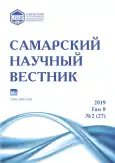Экологическая оценка территории с учетом функциональной неоднородности земель отдельных категорий
- Авторы: Глуховская М.Ю.1, Евстифеева Т.А.1, Гривко Е.В.1
-
Учреждения:
- Оренбургский государственный университет
- Выпуск: Том 8, № 2 (2019)
- Страницы: 23-28
- Раздел: 03.02.00 – общая биология
- URL: https://journals.rcsi.science/2309-4370/article/view/34292
- DOI: https://doi.org/10.17816/snv201982104
- ID: 34292
Цитировать
Полный текст
Аннотация
Повсеместная деградация природных экологических систем диктует необходимость установления их предела устойчивости и стабильности, которые, прежде всего, отображаются в изменении свойств компонентов окружающей среды в результате воздействия разнообразных факторов, в первую очередь антропогенных. Устойчивость выражается через коэффициент (Кэурт), определяемый как соотношение площадей территорий под элементами благоприятного и негативного воздействия. Определение коэффициента экологической стабильности (Кэс) подразумевает учет экологической значимости каждого из биотехнических элементов местности. Данная методика предполагает наличие несколько этапов исследований: анализ структуры земельного фонда региона, выявление приоритетных по площади категорий земель, оценку вклада отдельных биотехнических элементов внутри категорий в сохранение экологической устойчивости и стабильности. Исследования проводились на территории Оренбургской области, которая относится к субъектам с преобладанием агропромышленного сектора, отличающимся высокой скоростью роста нарушенных земель. Оценка производилась за период с 2002 по 2016 гг. В ходе исследования выявлено, что в регионе приоритетными по площади являются земли сельскохозяйственного назначения, на их долю приходится 88,5% от общей площади исследуемой территории. Данная категория земель подлежит, в зависимости от функционального использования, делению на пашни (55,9%), кормовые угодья (43,5%), многолетние насаждения (0,5%) и прочие земли (0,1%). Значение коэффициента стабильности в течение всего периода исследования в среднем составляет 0,36, что на 29,5% ниже минимальной нормы и характеризует территорию как малостабильную. Максимальное значение показателя устойчивости составляет 0,79 при оптимальном не менее 1, что позволяет отнести исследуемую территорию к категории «малоустойчивые». Полученные значения изучаемых параметров позволяют сделать выводы о выходе за рамки пределов устойчивости экосистем Оренбургской области и нарушении стабильности их развития. Снизить нагрузку на земельный фонд исследуемого региона позволит дифференцированный подход, на основе системы экологического районирования.
Полный текст
Открыть статью на сайте журналаОб авторах
Марина Юрьевна Глуховская
Оренбургский государственный университет
Email: commarina97@mail.ru
кандидат технических наук, доцент кафедры экологии и природопользования
Россия, ОренбургТатьяна Александровна Евстифеева
Оренбургский государственный университет
Email: ta_evst@mail.ru
кандидат сельскохозяйственных наук, доцент кафедры экологии и природопользования
Россия, ОренбургЕлена Васильевна Гривко
Оренбургский государственный университет
Автор, ответственный за переписку.
Email: grivko-ev@mail.ru
кандидат педагогических наук, доцент кафедры экологии и природопользования
Россия, ОренбургСписок литературы
- Айдаров И.П. Обустройство агроландшафтов России. М.: МГУП, 2007. 312 с.
- Блохин Е.В. Экология почв Оренбургской области: почвенные ресурсы, мониторинг, агроэкологическое районирование. Екатеринбург: УрО РАН, 1997. 228 с.
- Bucek A. Ecological stability and ecological stress in environmental geography // Sbornik Praci. 1988. Vol. 18. P. 69-75.
- Bucek A., Ungerman J. Complete land reformations in the territory of the productional-organisational unit Merin and agricultural utilization of the landscape // Zpravy Geografickeho. 1978. Vol. 15 (6-7). P. 93-104.
- Buček A., Lacina J. Supraregional territorial system of landscape-ecological stability of the former Czechoslovakia // Ekologia Bratislava. 1996. Vol. 15 (1). P. 71-76.
- Masný M., Zaušková L. Multi-temporal analysis of an agricultural landscape transformation and abandonment (Lubietová, Central Slovakia) // Open Geosciences. 2015. Vol. 7 (1). P. 888-896.
- Moyzeova M., Kenderessy P. Territorial systems of ecological stability in land consolidation projects (example of proposal for the lses of Klasov village, Slovak Republic) // Ekologia Bratislava. 2015. Vol. 34 (4). P. 356-370.
- Глуховская М.Ю., Евстифеева Т.А. Анализ устойчивости региональных территорий (на примере отдельного района Оренбургской области) // Университетский комплекс как региональный центр образования, науки и культуры: мат-лы всерос. науч.-метод. конф. (с междунар. участием). Оренбург: ОГУ, 2016. С. 779-785.
- Глуховская М.Ю. Анализ экологической устойчивости и стабильности региональной территории на примере Оренбургской области // Вестник Оренбургского государственного университета. 2017. № 4 (204). С. 53-61.
- Евстифеева Т.А., Глуховская М.Ю. Определение особенностей создания оптимальной структуры агроландшафтов Оренбургской области // Самарский научный вестник. 2017. Т. 6, № 2 (19). С. 35-40.
- Voloscuk I. Ecological stability in the Tatra mountains forests // Ekologia Bratislava. 1998. Vol. 17 (1). P. 39-48.
- Zaušková L. Landscape-ecological interpretation and applications of landscape survey results for optimal land use // Ekologia Bratislava. 2014. Vol. 33 (3). P. 252-258.
- Карев В.Б., Кавешников Н.Т. Экологическая устойчивость региональной территории // Роль природообустройства сельских территорий в обеспечении устойчивого развития АПК: мат-лы междунар. науч.-практ. конф. Ч. 2. М.: МГУП, 2007. С. 69-73.
- Исаченко А.Г. Экологическая география России. СПб.: Издат. дом СПбГУ, 2001. 328 с.
- Чибилев А.А. Географический атлас Оренбургской области. Оренбург: Оренбургское книжное издательство, 1999. 95 с.
- Земельный кодекс Российской Федерации от 25.10.2001 № 136-ФЗ (ред. от 25.12.2018) (с изм. и доп., вступ. в силу с 01.01.2019). Статья 85. Состав земель населенных пунктов и зонирование территорий [Электронный ресурс] // http://consultant.ru/ document/cons_doc_LAW_33773.
- Свод правил СП 42.13330.2011. Актуализированная редакция СНиП 2.07.01-89 Градостроительство. Планировка и застройка городских и сельских поселений [Электронный ресурс] // http://base.garant. ru/6180772/#ixzz5QVBkgs71.
Дополнительные файлы






